How to choose the most effective advertising platform?
Modern entrepreneurs actively use the internet to promote their products and services worldwide. Forgoing the time-consuming process of website SEO optimization, they often resort to paid web advertising. However, they face the question: where exactly should they promote their products? If we consider only the two main players in contextual advertising, the choice is between Yandex.Direct and Google Ads. Considering that not all entrepreneurs have the resources and time to simultaneously use both platforms, the choice becomes especially pressing.
Placing paid advertising on both Google and Yandex can attract a multitude of hot leads to your company. However, before launching an advertising campaign, it's important to carefully study the similarities and key differences between contextual advertising on Google and Yandex.
Common features of Google Ads and Yandex.Direct:
Both platforms allow you to quickly improve your website's search rankings, ensuring high visibility among potential customers interested in your products or services. Google contextual advertising Yandex can appear both at the top of search results and on partner sites, increasing the likelihood that users will notice your ad, click on it, and perform a targeted action, such as a purchase.
However, despite the apparent simplicity of these systems, there are several pitfalls:
- Cost of contextual advertising: Contextual advertising fees can be significant, especially in highly competitive environments. Large-scale advertising campaigns can also become costly.
- The need for proper ad setup: Campaign effectiveness directly depends on the correct ad setup in your account. Quality setup impacts reach, performance, and overall promotion costs.
It's important to keep in mind that both services are constantly evolving, offering new features and tools for advertisers. Therefore, before choosing a platform, you should also familiarize yourself with the latest updates and functionality of each service to maximize their potential in your advertising strategy.
Effective use of contextual advertising services requires not only creating an attractive ad, selecting display parameters and a payment format in the advertising account, but also constantly analyzing the results. Within a campaign, keywords, targeting, remarketing, budget forecasting, and other options are configured. Advertising setup is generally similar, including audience parameters, targeting, bids per click, and other aspects.
Let's look at the general and various aspects of managing Yandex and Google advertising accounts.
What do these tools have in common?
Both services offer several campaign types. Contextual ads and affiliate network advertising are the most common options. Contextual ads appear in search results, above or below organic search results, while affiliate network advertising expands reach to millions of sites, including relevant resources with engaged audiences and available clicks. Other campaign types include:
- Product feed advertising for e-commerce: smart banners in Yandex and product campaigns in Google.
- Campaigns for mobile app installs and in-app conversions.
- Video advertising format on YouTube from Google.
- Coverage campaigns on the main page or on Yandex services.
However, despite similar capabilities, there are differences in the advertising approaches on both platforms. Advertising is a paid service, and the final cost depends on a number of factors, such as the level of competition, display strategy, payment model, and other parameters taken into account by each system.
It's important to note that both Yandex and Google are constantly improving their services, offering new features and tools for advertisers. Therefore, it's crucial to stay up-to-date with the latest updates and functionality of each service to maximize their potential in your advertising strategy.
Differences between Google AdWords and Yandex.Direct
The differences between Google AdWords and Yandex.Direct in terms of advertising share offer businesses interesting options, especially when it comes to targeting audiences and conversions. Generally speaking, these two leading contextual advertising services share distinct spheres of influence: Google AdWords targets the global market, while Yandex.Direct focuses primarily on Russian audiences. However, depending on the nature of the business, advertising audiences can overlap and blend. The key considerations when choosing between them relate to the location of the target audience, reach, and expected click volume.
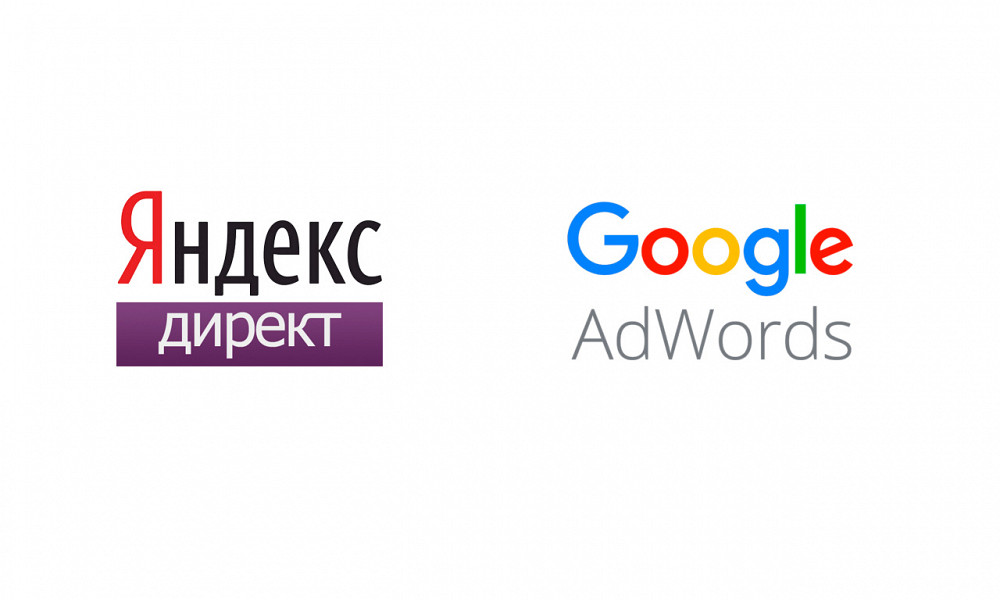
When considering conversion rates in the B2C segment, they typically range from 11 to 41 clicks per month on high-quality websites. This percentage largely depends on product characteristics, competition level, and other factors. In the B2B segment, conversion rates are typically lower. For example, if your goal is to close at least 10 deals per month, and assuming a conversion rate of 21 clicks per month, you'll need to attract at least 500 clicks during this period.
Therefore, it's important to determine which search engine generates more traffic: Yandex or Google. This is especially relevant if you decide to advertise on only one platform. According to statistics, Google generates more traffic, with a market share of just over 601,000,000, compared to Yandex, which holds a market share of 371,000,000.
While Google's user base has long been on the rise, the platform's influence may change with the introduction of a law requiring pre-installation of Russian software on devices. Effective July 1, 2020, this law applies to smartphones sold in Russia and will subsequently be expanded to include tablets, computers, and smart set-top boxes. For example, Samsung began pre-installing Yandex apps on its devices by default on March 31 of this year.
Therefore, the question of whether Yandex.Direct or Google AdWords is more effective should be considered in the context of a specific situation. Perhaps your target audience prefers Yandex, despite global reach data favoring Google. It's important to remember that a visit to your website doesn't guarantee a conversion. The key is to engage your audience and have a high-quality landing page, which in turn will increase the likelihood of the user completing the desired action.
Selecting suitable keywords
Selecting suitable keywords is a crucial step when launching an advertising campaign, and contextual advertising platforms like Yandex.Direct and Google Ads offer various tools for setting them up. Let's explore the differences in keyword management approaches across these two popular services.
Google Ads uses a broad match type by default. This means an ad can be displayed for various phrase forms, requiring advertisers to consider all possible variations. This is especially important to avoid irrelevant ad impressions.
Yandex.Direct uses special operators instead of match types. These operators allow you to refine the word form, their number in the query, their order, and other parameters. This provides a more flexible approach to keyword customization.
Google Ads also uses operators, but now, instead of the broad match modifier "+," it uses phrase match. This means that a phrase isn't limited to just the words it contains.
Before launching an advertising campaign, it's important to explore the operators and match types on both platforms. These features allow you to more accurately target the audience searching for your product or service.
An important aspect is the use of negative keywords, which filter out unwanted audiences. Both Yandex.Direct and Google Ads allow you to add negative keywords at the campaign and ad group level, as well as at the keyword level. However, Yandex.Direct allows you to set negative keywords directly at the keyword level, which can be useful for more precise targeting.
Before selecting keywords, it's recommended to conduct research and assess their popularity, competition level, and projected bids per impression or click. Google Ads uses the Keyword Planner tool for this purpose, located under "Tools" - "Planning." This tool allows you to more effectively define your keyword selection strategy.

Therefore, selecting and managing keywords for advertising campaigns on Yandex.Direct and Google Ads requires careful analysis and the use of available tools to maximize advertising effectiveness.
Setting up geolocation targeting
Geolocation targeting in contextual advertising is becoming an integral element of the strategy of many businesses operating in both Yandex.Direct and Google AdWords. This method allows for targeting ad impressions to specific regions, which is especially important for local businesses and companies.
The ability to target advertising to specific areas or parts of a city not only saves money but also helps attract the exact audience the advertiser is most interested in. This is especially important in highly competitive industries, where effective targeting is key to a successful campaign.
In Google Ads, advertisers can specify a display radius of up to 500 meters, allowing them to target specific areas of the city and attract potential customers. For example, for a small coffee shop, this means their ads will be visible to freelancers living in nearby areas, creating unique opportunities to attract new customers.
In Yandex.Direct, using the Yandex.Audience tool, there's an even more precise way to target ads by geolocation—down to the building level. This option is suitable, for example, for companies located within specific shopping centers or residential complexes, allowing them to deliver their advertising message to their target audience as effectively as possible.
Thus, using geolocation targeting in advertising campaigns is a powerful tool for businesses, helping not only save resources but also attract the audience with the greatest conversion potential. These opportunities open up new opportunities for local businesses and ensure highly effective advertising efforts.
Advertising budget
Budgeting in the context of advertising campaigns is a crucial step, and comparing it between Google Ads and Yandex.Direct is key when developing advertising strategies. Let's look at cost forecasting tools and learn how they are applied in each of these platforms.
To forecast your budget in Yandex.Direct, use the "Budget Forecast" feature, accessible from the "Tools" section of your advertising account. A similar tool in Google Ads is called "Keyword Planner" and can be found in the "Tools and Settings" section on the AdWords homepage.
Forecasting tools allow you to determine expected costs and reach for current keywords and geographic settings in advance. This provides advertisers with information for more effective budget management.
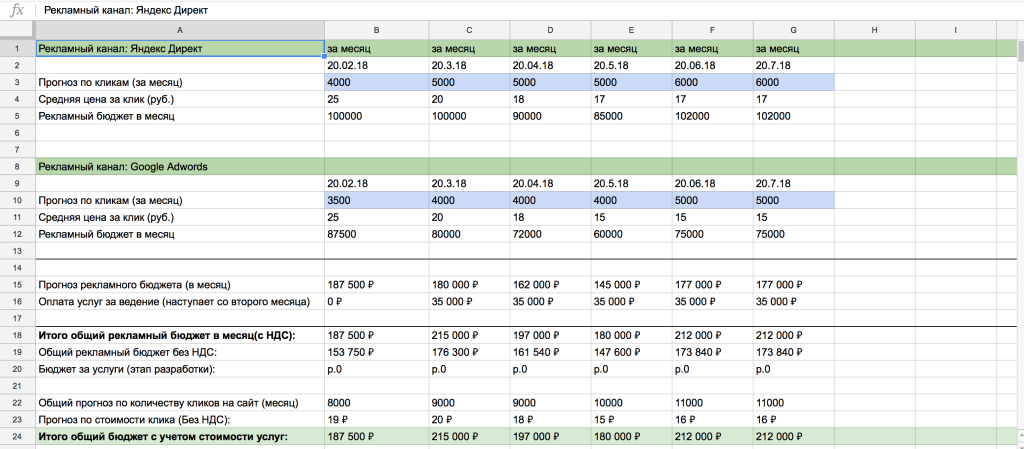
It's impossible to draw a definitive conclusion about whether Yandex or Google is cheaper to advertise on. Both services offer forecasting tools, but they're based on estimates. It's recommended to conduct calculations for your own contextual advertising on both platforms to determine where you can achieve the desired reach or clicks with the optimal budget.
Yandex and Google offer various display strategies on their contextual advertising platforms, allowing advertisers to choose the most appropriate option based on their goals and preferences.
Yandex.Direct:
Yandex.Direct offers eight automatic and three manual strategies. Automatic strategies allow the system to independently optimize ad placement based on campaign goals, whether increasing clicks, budget savings, or increasing conversions. With manual strategies, advertisers can influence display parameters during the campaign by adjusting the ad block, position, placement time, bids, and other settings. Third-party tools, such as bid managers, can be used for additional automation of bid management.
Google Ads:
Google Ads offers a variety of strategies, including automatic, flexible, and additional automated rules and scripts. Automatic strategies allow the system to select ad units and placements based on a specified daily budget and CPC. Advertisers can manually adjust the display time. With other strategies, advertisers specify the ad unit for placement, and the remaining parameters are adjusted automatically.
Both services provide advertisers with extensive options for customizing and optimizing display strategies to suit the unique requirements and goals of each advertising campaign.
Therefore, determining whether it's cheaper to promote through Google Ads or Yandex.Direct depends on the chosen strategies and the individual parameters of each campaign. Advertisers are offered various tools and strategies, and the right decision must be made based on each advertiser's unique needs and goals.
Interface
The interface is a key aspect of successfully launching contextual advertising on Google and Yandex. Understanding the capabilities of these tools allows you to maximize their functionality, resulting in more accurate and cost-effective advertising campaigns.
Google Ads:
When you log in to your Google Ads account, you'll find an overview dashboard with key statistics for all your current campaigns. Key metrics are presented here, such as clicks, impressions, average cost per click, and total cost. This dashboard is flexible and customizable: you can edit it to suit your preferences or use filters to focus on specific metrics, such as CTR.
However, for businesses, specific values for key transactions, revenue, and advertising ROI are often more important than general metrics. This is where ROMI Center's end-to-end analytics connectors come in handy, allowing you to integrate data from online and offline sources directly into your Google Ads report.
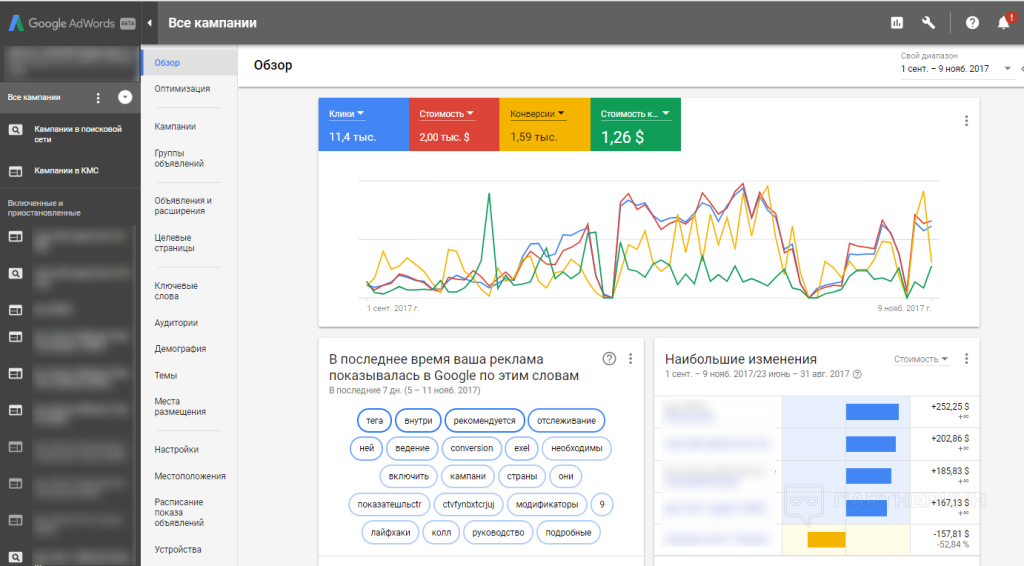
From the main dashboard page, you can easily navigate to your campaigns, search ads, and display ads. The main menu is located on the left, along with a secondary menu, providing convenient and quick access to the sections you need without unnecessary steps.
Yandex.Direct:
Since the beginning of 2019, Yandex.Direct has improved its personal account interface, providing users with more convenient access to information. The start screen now displays a list of campaigns with brief descriptions of their parameters. Navigation is provided using the top and side menus, providing users with an additional level of convenience and efficiency. The yellow "Add" button allows you to easily create campaigns, groups, ads, and add keywords.
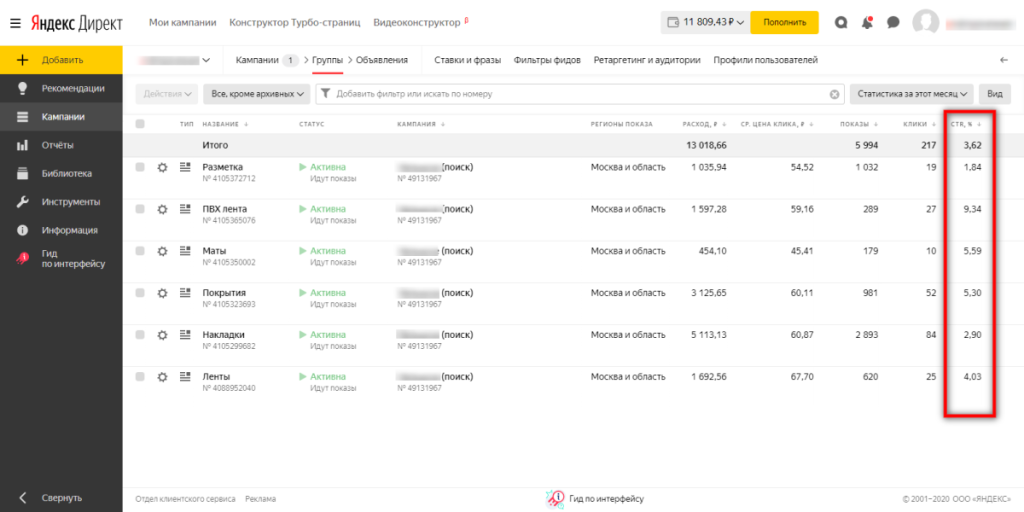
Other significant points include:
- Recommendations: Provide advice on how to improve advertising effectiveness and become available after statistics have been accumulated.
- Library: Contains settings for retargeting, audiences, feeds, creatives for smart banners, turbo pages, mobile apps, and negative keywords.
- Tools: Includes key campaign parameters, budget forecasting, keyword selection, and API.
- Information: Provides helpful tips, support contacts, case studies, and a training center.
Google Ads vs. Yandex.Direct:
Determining which interface is preferable—Google Ads or Yandex.Direct—is often only possible through personal experience. Advertisers can become accustomed to a particular system, which can make switching difficult. Some prefer to use standard features and find them easily accessible in any menu. Experimenting with creating and setting up ads in both systems can help you make a more informed decision.
Additional system options:
- Ineffective Site Filter: Google Ads provides a filter for the Display Network (GDN), but sometimes requires pre-loading the filter before launching a campaign. Yandex.Direct allows you to disable sites in the YAN that haven't driven conversions, providing a more flexible approach.
- Ad formats: Both services support a variety of formats, including text, image, text and image, rich media, and video. Experimenting with the same ad in both systems can reveal subtleties that affect campaign results.
- Selecting specific websites for impressions: Google Ads offers the option to select specific websites in the Display Network, while Yandex.Direct allows this by setting the desired website's domain as a keyword. The results may be similar, but the approaches are different.
Efficiency and Analysis in Yandex.Direct and Google Ads: The Superiority of End-to-End Analytics
After successfully launching an advertising campaign, analyzing its effectiveness becomes an important step. Monitoring key metrics such as views, clicks, and conversions will help determine further steps to improve results. The question arises: is it more effective to analyze data in Yandex.Direct or Google Ads?
Both platforms are equipped with a built-in analytics system that provides basic information on campaign progress. However, for more in-depth statistics and valuable recommendations for improving KPIs, it is recommended to use end-to-end analytics tools. These services integrate directly with Google or Yandex, providing data collection in a user-friendly interface. One popular example of such analytics is ROMI Center.
The main differences between the analytics tools in AdWords and Yandex.Direct relate to their names, connection algorithms, and end-to-end analytics connectors. AdWords uses Google Analytics, while Yandex.Direct integrates with Yandex.Metrica. Both integrated web analytics systems provide comprehensive information on advertising campaign costs.
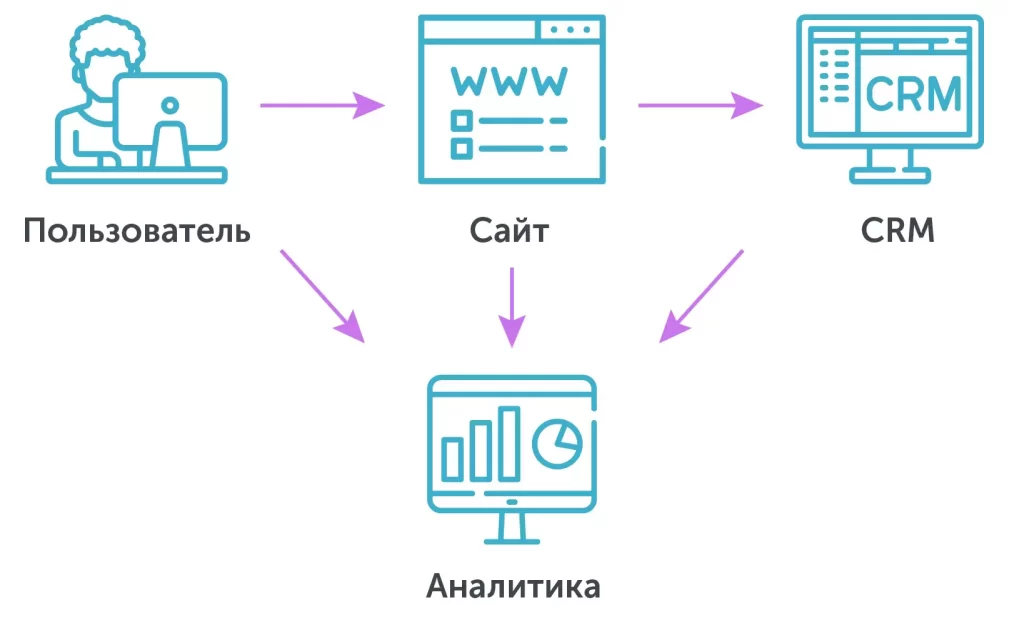
Predicting the effectiveness of a campaign on each platform is difficult. Yandex and Google audiences have become nearly identical, and bids and pricing operate similarly. Generally, similar results can be expected when running contextual advertising on Yandex.Direct and Google Ads. However, nuances can only emerge through experimentation, and the use of integrated analytics solutions can be key to optimizing results.
Conclusion: Comparing Yandex.Direct and Google Ads for the Optimal Advertising Partnership
Analyzing Yandex.Direct and Google Ads, it becomes clear that determining the best one is no easy task. If your budget allows, it's recommended to run small test campaigns in both systems. This approach will allow you to objectively evaluate the effectiveness of each, taking into account the specifics of your business, region, and timeframe.
Advertising settings may differ between Yandex.Direct and Google Ads, but both systems are constantly being improved to achieve parity. The choice between them may depend on geolocation—for example, the need to cover a specific radius or building. Also, if you have thematic partner platforms, their presence may influence the choice between the Display Network and the YAN.
If you prefer to start with a single search engine, we recommend running ads on Yandex. Since Yandex users tend to access the search engine from desktops, it's easier to attract them with ads. Yandex search can also help you assess demand for your product or service.
Google Ads can certainly deliver higher traffic and lower CPCs. However, due to its focus on YouTube and mobile web, Google's audiences generate fewer conversions. Ineffective Display Network platforms can create additional challenges for businesses.
Regardless of the choice, SEO website optimization Campaign performance plays a key role. Once results are in, using end-to-end analytics will help you refine your ads. Thorough analysis and continuous improvement are the keys to a successful advertising strategy.







